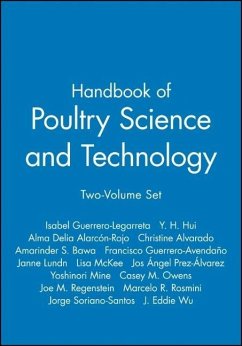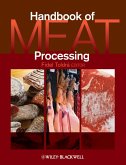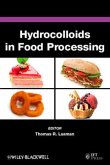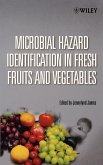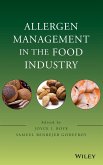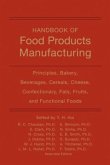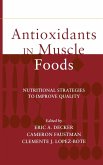Isabel Guerrero-Legarreta / Y. H. Hui / Alma Delia et al. Alarcón-Rojo (Hrsg.)
Handbook of Poultry Science and Technology, Set
Ed. by Isabel Guerrero-Legarreta, Yiu H. Hui, Alma D. Alarcón-Rojo et al.
Isabel Guerrero-Legarreta / Y. H. Hui / Alma Delia et al. Alarcón-Rojo (Hrsg.)
Handbook of Poultry Science and Technology, Set
Ed. by Isabel Guerrero-Legarreta, Yiu H. Hui, Alma D. Alarcón-Rojo et al.
- Gebundenes Buch
- Merkliste
- Auf die Merkliste
- Bewerten Bewerten
- Teilen
- Produkt teilen
- Produkterinnerung
- Produkterinnerung
Poultry science covers raising and managing healthy chickens, turkeys, and ducks for eggs or meat. From live poultry up until retail production, Handbook of Poultry Processing provides an updated and comprehensive reference on everything related to the poultry industry, including scientific, technical, and engineering principles, methods, and product categories. This definitive resource covers the link between meat quality and production process, which can help in solving potential quality problems, making this two volume set an essential tool for all practitioners, libraries, scientists, researchers, and academics in this field.…mehr
Andere Kunden interessierten sich auch für
![Handbook of Meat Processing Handbook of Meat Processing]() Handbook of Meat Processing339,99 €
Handbook of Meat Processing339,99 €![Hydrocolloids in Food Processing Hydrocolloids in Food Processing]() Hydrocolloids in Food Processing257,99 €
Hydrocolloids in Food Processing257,99 €![Microbial Hazard Identification in Fresh Fruits and Vegetables Microbial Hazard Identification in Fresh Fruits and Vegetables]() Jennylynd James (ed.)Microbial Hazard Identification in Fresh Fruits and Vegetables165,99 €
Jennylynd James (ed.)Microbial Hazard Identification in Fresh Fruits and Vegetables165,99 €![Kirk-Othmer Food and Feed Technology, 2 Volume Set Kirk-Othmer Food and Feed Technology, 2 Volume Set]() WileyKirk-Othmer Food and Feed Technology, 2 Volume Set677,99 €
WileyKirk-Othmer Food and Feed Technology, 2 Volume Set677,99 €![Allergen Management in the Food Industry Allergen Management in the Food Industry]() Joyce I. BoyeAllergen Management in the Food Industry194,99 €
Joyce I. BoyeAllergen Management in the Food Industry194,99 €![Handbook of Food Products Manufacturing, 2 Volume Set Handbook of Food Products Manufacturing, 2 Volume Set]() Nirmal K SinhaHandbook of Food Products Manufacturing, 2 Volume Set817,99 €
Nirmal K SinhaHandbook of Food Products Manufacturing, 2 Volume Set817,99 €![Antioxidants in Muscle Foods Antioxidants in Muscle Foods]() Eric A DeckerAntioxidants in Muscle Foods264,99 €
Eric A DeckerAntioxidants in Muscle Foods264,99 €-
-
-
Poultry science covers raising and managing healthy chickens, turkeys, and ducks for eggs or meat. From live poultry up until retail production, Handbook of Poultry Processing provides an updated and comprehensive reference on everything related to the poultry industry, including scientific, technical, and engineering principles, methods, and product categories. This definitive resource covers the link between meat quality and production process, which can help in solving potential quality problems, making this two volume set an essential tool for all practitioners, libraries, scientists, researchers, and academics in this field.
Hinweis: Dieser Artikel kann nur an eine deutsche Lieferadresse ausgeliefert werden.
Hinweis: Dieser Artikel kann nur an eine deutsche Lieferadresse ausgeliefert werden.
Produktdetails
- Produktdetails
- Verlag: Wiley & Sons / Wiley-Blackwell
- 1. Auflage
- Seitenzahl: 1484
- Erscheinungstermin: 22. Februar 2010
- Englisch
- Abmessung: 241mm x 165mm x 81mm
- Gewicht: 2240g
- ISBN-13: 9780470185377
- ISBN-10: 0470185376
- Artikelnr.: 26818215
- Herstellerkennzeichnung
- Libri GmbH
- Europaallee 1
- 36244 Bad Hersfeld
- gpsr@libri.de
- Verlag: Wiley & Sons / Wiley-Blackwell
- 1. Auflage
- Seitenzahl: 1484
- Erscheinungstermin: 22. Februar 2010
- Englisch
- Abmessung: 241mm x 165mm x 81mm
- Gewicht: 2240g
- ISBN-13: 9780470185377
- ISBN-10: 0470185376
- Artikelnr.: 26818215
- Herstellerkennzeichnung
- Libri GmbH
- Europaallee 1
- 36244 Bad Hersfeld
- gpsr@libri.de
Isabel Guerrero-Legarreta, the lead editor, is a Professor in the Biotechnology Department at the Universidad Autó'noma Metropolitana in Mexico. She has expertise in the meat and poultry sciences; and she has published over 80 manuscripts, 5 books, and 29 book chapters. Y.H. Hui, the Administrative Editor, is the Senior Scientist at Science Technology System and has been the author or editor of many books in Food Science and Technology.
VOLUME 1
PART 1: POULTRY BIOLOGY TO PRE-MORTEM STATUS.
1. Poultry classification/biology.
2. Competitive exclusion.
3. Pre mortem handling.
4. Transportation.
PART 2:SLAUGHTER/CUTTING.
5. The slaughterhouse: building.
6. Slaughtering equipment.
7. Carcass evaluation and cutting.
8. Official control.
9. Packaging.
10. Kosher slaughter.
11. Halal slaughter.
PART 3: PRESERVATION: FREEZING.
12. Biochemical changes.
13. Physicochemical changes.
14. Low temperature storage.
15. Engineer. principles of freezing.
16. Quality of frozen poultry Sendra.
17. Quality of refrigerated poultry.
18. Refrigeration: equipment.
19. Freezing: equipment.
20. Refri./freezing retails.
21. Refri./freezing industr. Facilities.
PART 4 PRESERVATION: HEATING.
22. Heating, drying, chemicals.
23. Irradiation.
PART 5: COMPOSITION, CHEMISTRY, AND SENSORY.
24. Quality characteristics.
25. Chemical composition.
26. Texture and tenderness.
27. PSE.
PART 6: EGGS.
28. Eggs attributes.
29. Eggs Science and Technology.
PART 7: SANITATION AND SAFETY.
Section 1: Sanitation, regulations and disease outbreaks.
30. Chemical residues.
31. Microbiology of fresh poultry meat.
32. Principles of HACCP Wendakeen.
33. HACCP in poultry slaughterhouses.
34. Online-inspection.
35. Poultry/foodborne diseas. in US.
36. Poultry foodborne diseasess in Central and South America.
SECTION 5: WORKERS SAFETYY.
37. OSHA: basic considerations.
38. Etools.
VOLUME 2.
PART 1: SECONDARY PROCESSING.
1. Secondary processing.
PART 2: METHODS IN PROCESSING.
2. Emulsions: Principles.
3. Emulsions: Applications.
4. Breading: Principles.
5. Breading: Frying and freezing.
6. Mechan. deboning: Principles.
7. Mechan. deboning: Applications.
8. Marination: Principles.
9. Marination: Applications.
10. Non-meat ingredients.
PART 3: PRODUCT MANUFACTURING.
11. An overview on processed meat.
12. Canned poultry meat.
13. Turkey bacon.
14. Turkey sausages.
15. Breaded product (nuggets).
16. Paste product (paté).
17. Poultry ham.
18. Luncheon meat.
19. Eggs in processed products.
20. Special dietary products.
PART 4: PRODUCT QUALITY.
21. Sensory attributes.
22. Texture and tenderness.
23. Protein and poultry meat quality.
24. Flavors.
25. Color.
26. Refrigerated poultry handling.
PART 5: ENGINEERING PRINCIPLES.
27. Basic operations and conditions.
28. Processing equipment.
29. Thermal processing.
30. Packaging.
PART 6: CONTAMINANTS.
31. Contamination.
32. Microbial ecology and spoilage.
33. Campylobacter.
34. Microbiology: ready-to-eat.
35. Chemical analysis.
36. Microbial analysis.
PART 7: U.S. SAFETY SYSTEMS.
37. Sanitation requirements in US.
38. Principles of HACCP.
39. Enforcement tools in US.
PART 1: POULTRY BIOLOGY TO PRE-MORTEM STATUS.
1. Poultry classification/biology.
2. Competitive exclusion.
3. Pre mortem handling.
4. Transportation.
PART 2:SLAUGHTER/CUTTING.
5. The slaughterhouse: building.
6. Slaughtering equipment.
7. Carcass evaluation and cutting.
8. Official control.
9. Packaging.
10. Kosher slaughter.
11. Halal slaughter.
PART 3: PRESERVATION: FREEZING.
12. Biochemical changes.
13. Physicochemical changes.
14. Low temperature storage.
15. Engineer. principles of freezing.
16. Quality of frozen poultry Sendra.
17. Quality of refrigerated poultry.
18. Refrigeration: equipment.
19. Freezing: equipment.
20. Refri./freezing retails.
21. Refri./freezing industr. Facilities.
PART 4 PRESERVATION: HEATING.
22. Heating, drying, chemicals.
23. Irradiation.
PART 5: COMPOSITION, CHEMISTRY, AND SENSORY.
24. Quality characteristics.
25. Chemical composition.
26. Texture and tenderness.
27. PSE.
PART 6: EGGS.
28. Eggs attributes.
29. Eggs Science and Technology.
PART 7: SANITATION AND SAFETY.
Section 1: Sanitation, regulations and disease outbreaks.
30. Chemical residues.
31. Microbiology of fresh poultry meat.
32. Principles of HACCP Wendakeen.
33. HACCP in poultry slaughterhouses.
34. Online-inspection.
35. Poultry/foodborne diseas. in US.
36. Poultry foodborne diseasess in Central and South America.
SECTION 5: WORKERS SAFETYY.
37. OSHA: basic considerations.
38. Etools.
VOLUME 2.
PART 1: SECONDARY PROCESSING.
1. Secondary processing.
PART 2: METHODS IN PROCESSING.
2. Emulsions: Principles.
3. Emulsions: Applications.
4. Breading: Principles.
5. Breading: Frying and freezing.
6. Mechan. deboning: Principles.
7. Mechan. deboning: Applications.
8. Marination: Principles.
9. Marination: Applications.
10. Non-meat ingredients.
PART 3: PRODUCT MANUFACTURING.
11. An overview on processed meat.
12. Canned poultry meat.
13. Turkey bacon.
14. Turkey sausages.
15. Breaded product (nuggets).
16. Paste product (paté).
17. Poultry ham.
18. Luncheon meat.
19. Eggs in processed products.
20. Special dietary products.
PART 4: PRODUCT QUALITY.
21. Sensory attributes.
22. Texture and tenderness.
23. Protein and poultry meat quality.
24. Flavors.
25. Color.
26. Refrigerated poultry handling.
PART 5: ENGINEERING PRINCIPLES.
27. Basic operations and conditions.
28. Processing equipment.
29. Thermal processing.
30. Packaging.
PART 6: CONTAMINANTS.
31. Contamination.
32. Microbial ecology and spoilage.
33. Campylobacter.
34. Microbiology: ready-to-eat.
35. Chemical analysis.
36. Microbial analysis.
PART 7: U.S. SAFETY SYSTEMS.
37. Sanitation requirements in US.
38. Principles of HACCP.
39. Enforcement tools in US.
VOLUME 1
PART 1: POULTRY BIOLOGY TO PRE-MORTEM STATUS.
1. Poultry classification/biology.
2. Competitive exclusion.
3. Pre mortem handling.
4. Transportation.
PART 2:SLAUGHTER/CUTTING.
5. The slaughterhouse: building.
6. Slaughtering equipment.
7. Carcass evaluation and cutting.
8. Official control.
9. Packaging.
10. Kosher slaughter.
11. Halal slaughter.
PART 3: PRESERVATION: FREEZING.
12. Biochemical changes.
13. Physicochemical changes.
14. Low temperature storage.
15. Engineer. principles of freezing.
16. Quality of frozen poultry Sendra.
17. Quality of refrigerated poultry.
18. Refrigeration: equipment.
19. Freezing: equipment.
20. Refri./freezing retails.
21. Refri./freezing industr. Facilities.
PART 4 PRESERVATION: HEATING.
22. Heating, drying, chemicals.
23. Irradiation.
PART 5: COMPOSITION, CHEMISTRY, AND SENSORY.
24. Quality characteristics.
25. Chemical composition.
26. Texture and tenderness.
27. PSE.
PART 6: EGGS.
28. Eggs attributes.
29. Eggs Science and Technology.
PART 7: SANITATION AND SAFETY.
Section 1: Sanitation, regulations and disease outbreaks.
30. Chemical residues.
31. Microbiology of fresh poultry meat.
32. Principles of HACCP Wendakeen.
33. HACCP in poultry slaughterhouses.
34. Online-inspection.
35. Poultry/foodborne diseas. in US.
36. Poultry foodborne diseasess in Central and South America.
SECTION 5: WORKERS SAFETYY.
37. OSHA: basic considerations.
38. Etools.
VOLUME 2.
PART 1: SECONDARY PROCESSING.
1. Secondary processing.
PART 2: METHODS IN PROCESSING.
2. Emulsions: Principles.
3. Emulsions: Applications.
4. Breading: Principles.
5. Breading: Frying and freezing.
6. Mechan. deboning: Principles.
7. Mechan. deboning: Applications.
8. Marination: Principles.
9. Marination: Applications.
10. Non-meat ingredients.
PART 3: PRODUCT MANUFACTURING.
11. An overview on processed meat.
12. Canned poultry meat.
13. Turkey bacon.
14. Turkey sausages.
15. Breaded product (nuggets).
16. Paste product (paté).
17. Poultry ham.
18. Luncheon meat.
19. Eggs in processed products.
20. Special dietary products.
PART 4: PRODUCT QUALITY.
21. Sensory attributes.
22. Texture and tenderness.
23. Protein and poultry meat quality.
24. Flavors.
25. Color.
26. Refrigerated poultry handling.
PART 5: ENGINEERING PRINCIPLES.
27. Basic operations and conditions.
28. Processing equipment.
29. Thermal processing.
30. Packaging.
PART 6: CONTAMINANTS.
31. Contamination.
32. Microbial ecology and spoilage.
33. Campylobacter.
34. Microbiology: ready-to-eat.
35. Chemical analysis.
36. Microbial analysis.
PART 7: U.S. SAFETY SYSTEMS.
37. Sanitation requirements in US.
38. Principles of HACCP.
39. Enforcement tools in US.
PART 1: POULTRY BIOLOGY TO PRE-MORTEM STATUS.
1. Poultry classification/biology.
2. Competitive exclusion.
3. Pre mortem handling.
4. Transportation.
PART 2:SLAUGHTER/CUTTING.
5. The slaughterhouse: building.
6. Slaughtering equipment.
7. Carcass evaluation and cutting.
8. Official control.
9. Packaging.
10. Kosher slaughter.
11. Halal slaughter.
PART 3: PRESERVATION: FREEZING.
12. Biochemical changes.
13. Physicochemical changes.
14. Low temperature storage.
15. Engineer. principles of freezing.
16. Quality of frozen poultry Sendra.
17. Quality of refrigerated poultry.
18. Refrigeration: equipment.
19. Freezing: equipment.
20. Refri./freezing retails.
21. Refri./freezing industr. Facilities.
PART 4 PRESERVATION: HEATING.
22. Heating, drying, chemicals.
23. Irradiation.
PART 5: COMPOSITION, CHEMISTRY, AND SENSORY.
24. Quality characteristics.
25. Chemical composition.
26. Texture and tenderness.
27. PSE.
PART 6: EGGS.
28. Eggs attributes.
29. Eggs Science and Technology.
PART 7: SANITATION AND SAFETY.
Section 1: Sanitation, regulations and disease outbreaks.
30. Chemical residues.
31. Microbiology of fresh poultry meat.
32. Principles of HACCP Wendakeen.
33. HACCP in poultry slaughterhouses.
34. Online-inspection.
35. Poultry/foodborne diseas. in US.
36. Poultry foodborne diseasess in Central and South America.
SECTION 5: WORKERS SAFETYY.
37. OSHA: basic considerations.
38. Etools.
VOLUME 2.
PART 1: SECONDARY PROCESSING.
1. Secondary processing.
PART 2: METHODS IN PROCESSING.
2. Emulsions: Principles.
3. Emulsions: Applications.
4. Breading: Principles.
5. Breading: Frying and freezing.
6. Mechan. deboning: Principles.
7. Mechan. deboning: Applications.
8. Marination: Principles.
9. Marination: Applications.
10. Non-meat ingredients.
PART 3: PRODUCT MANUFACTURING.
11. An overview on processed meat.
12. Canned poultry meat.
13. Turkey bacon.
14. Turkey sausages.
15. Breaded product (nuggets).
16. Paste product (paté).
17. Poultry ham.
18. Luncheon meat.
19. Eggs in processed products.
20. Special dietary products.
PART 4: PRODUCT QUALITY.
21. Sensory attributes.
22. Texture and tenderness.
23. Protein and poultry meat quality.
24. Flavors.
25. Color.
26. Refrigerated poultry handling.
PART 5: ENGINEERING PRINCIPLES.
27. Basic operations and conditions.
28. Processing equipment.
29. Thermal processing.
30. Packaging.
PART 6: CONTAMINANTS.
31. Contamination.
32. Microbial ecology and spoilage.
33. Campylobacter.
34. Microbiology: ready-to-eat.
35. Chemical analysis.
36. Microbial analysis.
PART 7: U.S. SAFETY SYSTEMS.
37. Sanitation requirements in US.
38. Principles of HACCP.
39. Enforcement tools in US.

